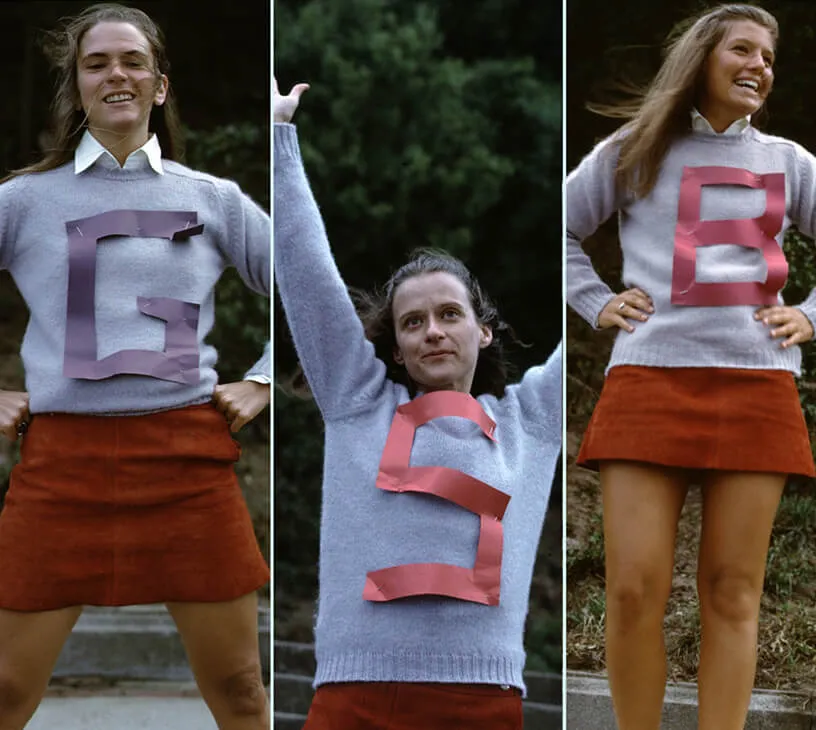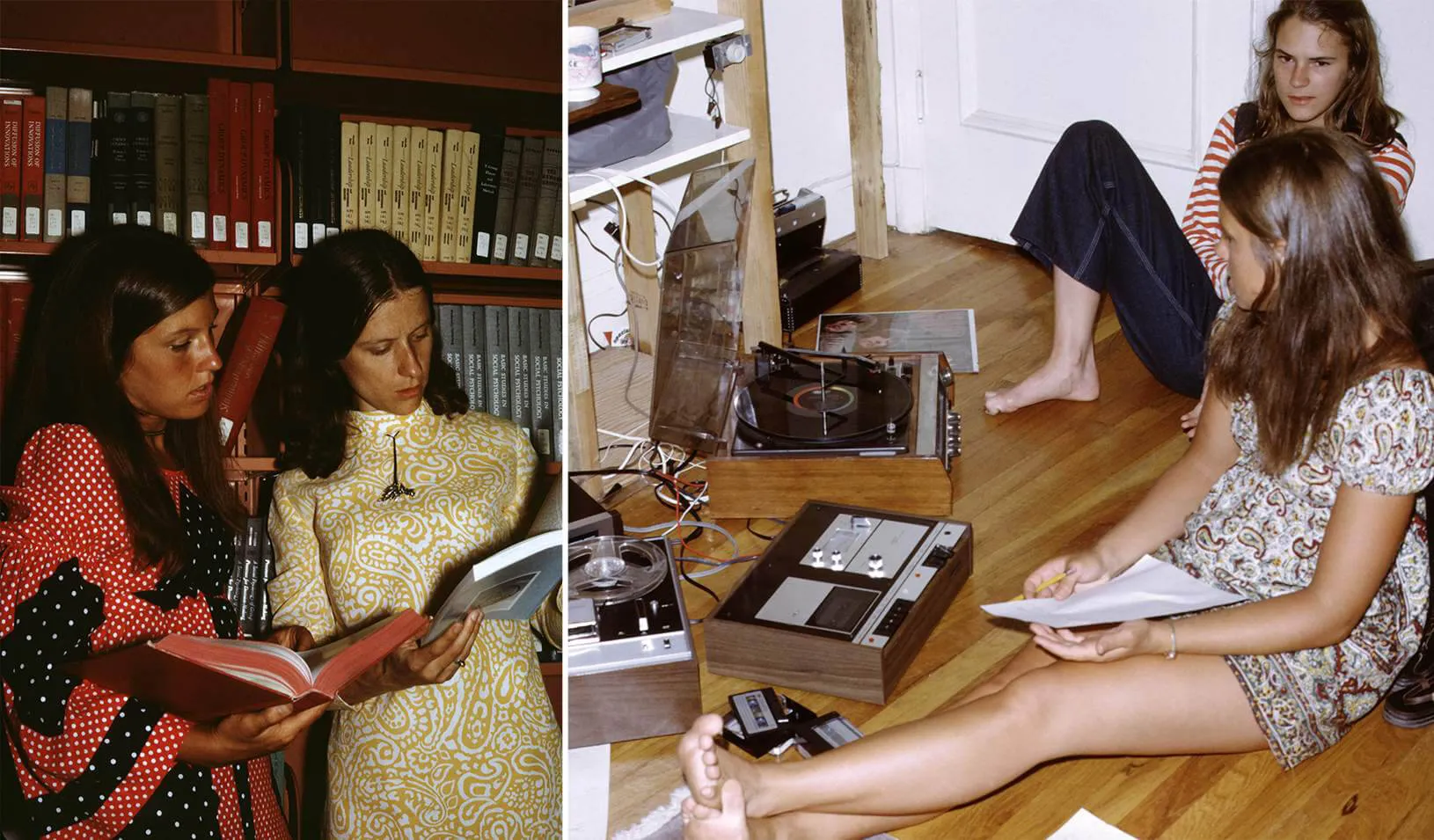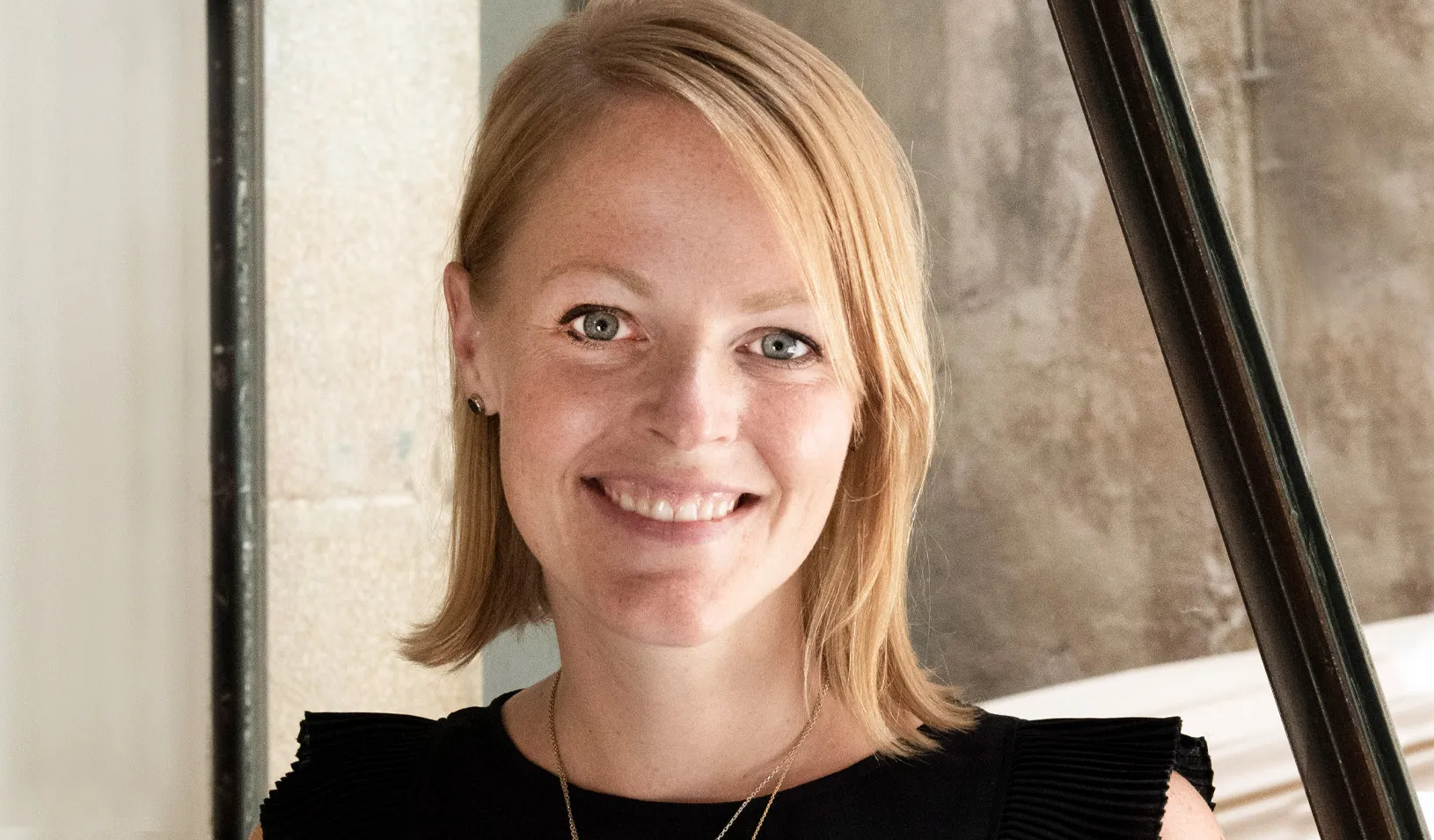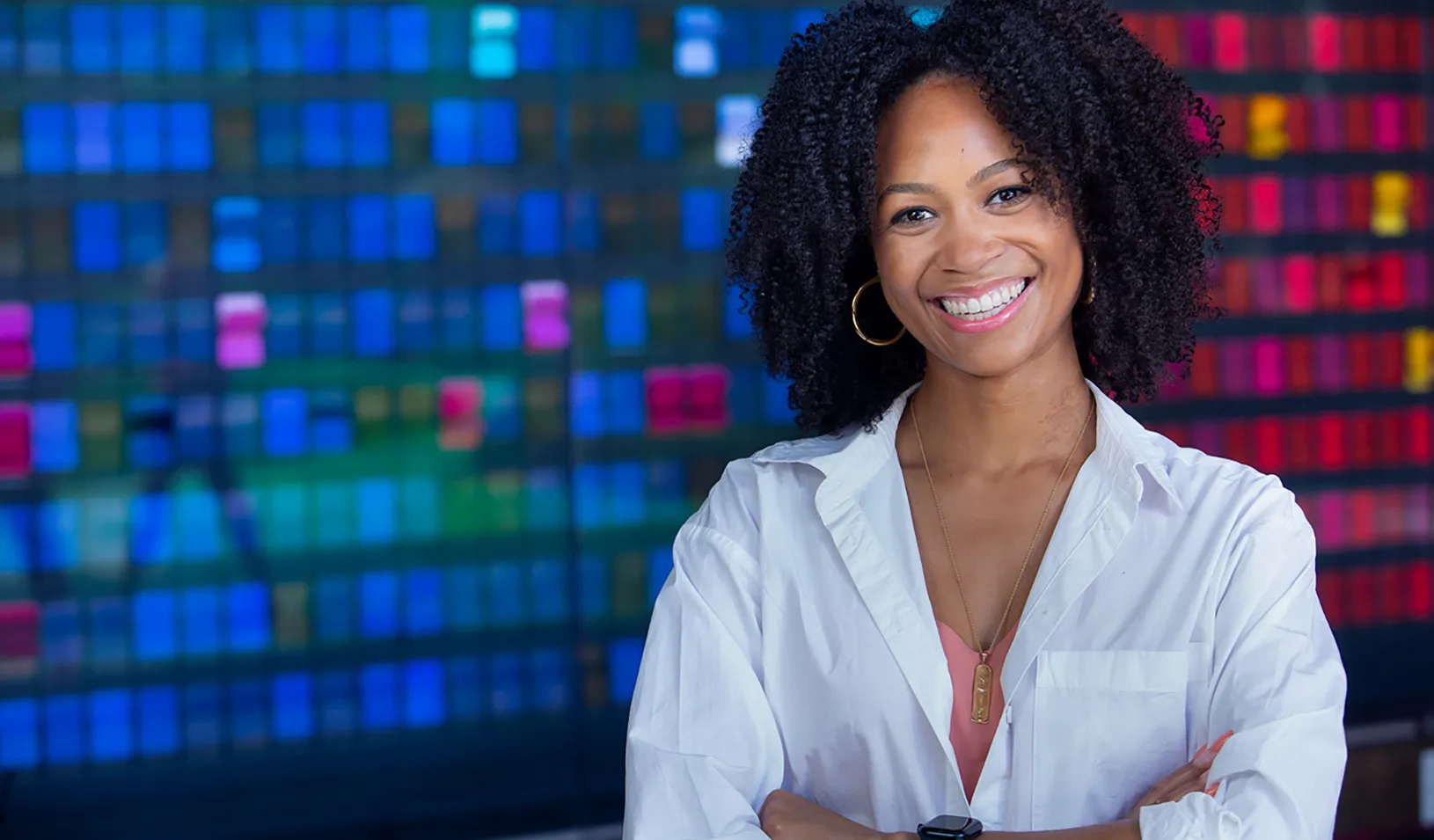The Women of the Class of ’72 Look Back, Nearly 50 Years Later
Enrolling at Stanford GSB at the height of the women’s movement was an inflection point for both the students and the school.
October 20, 2021

“The real impact of having women in the school was not so much a feminizing effect but a humanizing one.” | Courtesy of Susan Phillips, Anne Thornton, and Barbara West, with special thanks to Luther Nussbaum
Rising through the ranks of an educational publishing company in Palo Alto in the 1960s, Barbara West decided she would prefer to be in charge. Maybe, she thought, an MBA would help.
But her first interview with an admissions dean at Stanford GSB did not go well.
“He picked up on the fact that my father worked for Kodak, and he said, ‘Oh, are you a member of the Eastman family?’” She was not.
“Do you have a family fortune or a family business that will be yours to run?” No again.

The women, including Anne Thornton, Barbara West, and Susan Phillips (left to right), took the “Nice Girls” presentation on the road to recruit more female applicants. | Courtesy of Susan Phillips, Anne Thornton, and Barbara West, with special thanks to Luther Nussbaum
As West recalls that long-ago conversation, the dean then told her, “We might as well save our time: We only admit women who have either a family fortune or business to run, and since you don’t, why, there’s no place for you here.”
That was 1967. Three years later, with the women’s movement cresting, West tried again — and her reception could not have been more different. Gary Williams, Stanford GSB’s new dean of admissions and financial aid, was open to female, minority, and other nontraditional applicants. “I was focused on admitting the very best people I could — and that was all,” Williams says.
West would become one of five women among 308 students in the Class of 1972. Tiny as it was, it was one of the largest female cohorts the school had ever welcomed — an inflection point for both the school and the women themselves.
The summer after their first year, West and two of her classmates, Anne Thornton and Susan Phillips, collaborated on a multimedia presentation about their experiences at Stanford GSB, titled “What’s a Nice Girl Like You Doing in a Place Like This?” It described their emotional struggles in the face of skepticism from classmates and the faculty, which was all male until 1972. Scored with music of the era, including the Beatles’ “It’s Getting Better All the Time” and Aretha Franklin’s “Respect,” the show also expressed their hope for broader acceptance of women’s changing roles and aspirations.
Toward the end of the presentation, West said, “If another woman were to say, ‘Should I come to business school?’ my answer would be, ‘If that is the area you want to go into, hell yes, it’s well worth it.’”
Leonade Jones, another path-breaking member of the Class of 1972, attributes her passion for education to her parents. Her father ran the information window at the main post office in Washington, DC, while her mother was a clerk in the city’s public health department. “They felt they wanted better for their kids,” Jones says. “They believed that education would make a difference — not only for income potential, but for the quality of your life.”
Jones attended Catholic schools on scholarships, riding three buses to get to high school. After two years at the University of Pittsburgh, she transferred to Simmons College for a business degree. Margaret Hennig, a founding dean of the Simmons Graduate School of Management who’d later write a “survival manual” for women in business, encouraged her to consider an MBA. A veteran of summer jobs that included waitressing and being “a terrible secretary,” Jones needed little persuasion.
“I felt that to make my way in the world, I needed really stellar credentials,” Jones says, “and at that time I hadn’t really decided what the path might be.” Keeping her options open, she enrolled in a joint program in law and business at Stanford. She would become the first Black woman to earn that double degree from the university, and one of the first three to receive a Stanford MBA, in 1973.
Like Jones, the four other women in the class shared a sense of purpose and possibility. Anne Thornton was the daughter of a “frustrated housewife” and a lawyer who entered the ministry and advocated the ordination of women. She attended Radcliffe College and then, briefly, Harvard Law. After her then-husband received a Harvard MBA, they decided to relocate to San Francisco. Like Jones, she entered Stanford’s JD/MBA program. “I wanted to know how the world works,” she says.
Anne Wyser-Pratte got an early start in the work world when her father, a chemical engineer, became severely ill. To help support her family, she took a full-time position as a laboratory assistant when she was still in high school. She kept the job while earning a joint degree in biology and chemistry at the University of Florida. She was subsequently recruited as a research assistant in the Harvard biology lab of James Watson, who had shared a Nobel Prize in 1962 for describing the structure of DNA. Married at 21, Wyser-Pratte followed her husband to the Netherlands and then to Nicaragua, where she helped to start a health care clinic for poor patients. Her role was “mostly delivering babies,” despite her lack of medical training. “Who else was going to do it?”
After graduating from Reed College with a degree in experimental psychology, Barbara West found a job as a typist for an educational publishing company. “It took them about three days to figure out it was a mistake,” she says. But during an exit interview, the president asked if she knew anything about number theory. Thanks to a college math class, she did. After she rewrote a mathematics textbook for the company, she moved on to write, edit, copyedit, design, and even serve as corporate secretary and treasurer. Then she realized: “What I was interested in was running the place.”
Susan Phillips grew up in California. Her father, an engineer and an MBA, was especially supportive: “He would say, ‘You can be whatever you want to be. You could be a female president of the United States.’” But when she tried to enroll in a doctoral program in organizational behavior at Stanford GSB, she remembers a dean telling her: “We don’t admit women.” She turned to the MBA program instead.
In their first year, four of the five women were placed in a special, more diverse section that also included many of the class’s minority students. Wyser-Pratte remembers being asked if she would mind being the lone female in another section. “Most of my background was in all-male environments,” she says, “so it didn’t faze me in the least.”
Unsurprisingly, the five women encountered resistance to their presence on campus. “There were faculty and fellow classmates who thought we didn’t belong,” Phillips says. “They wondered, were we normal? Does this mean we don’t want the things they thought good women would want, like marriage and family?”
It helped that they had one another’s backs.
During their first week, when Phillips walked into an economics class, the professor scoffed, “You’re an MBA?”
“She sure is,” Thornton called out from a back row, cementing a lifelong friendship.
“I’ll just never forget that gesture of feminist solidarity,” says Phillips, who would become vice president of the Class of 1972. “Anne was two years ahead of me in age and schooling, and she was much more aware of these gender dynamics in the world. And she had already become a strong feminist.”
“I was very outspoken,” Thornton says. “And I wasn’t scared.”
Thornton remembers the time she trolled a recruiter from the Los Angeles office of a prestigious consulting firm. She showed up for a campus interview in jeans and said, “I’ve heard that you’ll talk to us, but you don’t really hire women as consultants.”
“We don’t,” he told her. “It’s good that we can be honest about it.”
Thornton believed that was illegal. She reported the recruiter to the campus placement office.
The women frequently compared notes about remarks that seemed sexist, West says, wondering if they were being “unduly sensitive.” When one professor made a wisecrack denigrating women, West approached him afterwards. “You told a really great joke in class today. I really thought it was hilarious,” she said. “But you used a woman. Could you tell the story again using a Black person?” It took him a moment, but he got the point.
For Jones, the joint JD/MBA schedule was onerous, and the pressure to succeed especially intense. She feared classmates or professors might attribute any failure “to the fact that I was either female or African American.” She told herself: “Don’t screw it up, because people are looking at you, and if you don’t do well, then it’ll be harder for the people who come behind you.”
Wyser-Pratte faced challenges at home. Her husband drove their car to his consulting job, obliging her to bike daily from Los Altos to Palo Alto “rain or shine, light or dark.” Nevertheless, she excelled academically, helped create a public-management program, and won the Ernest C. Arbuckle Award for her contributions to the school. But her domestic situation deteriorated. “My husband and I subsequently divorced because he was furious that I got an MBA,” she says. (In her second-year classes, she met both her second husband and her third, Chris Wyser-Pratte, a retired investment banker to whom she has been married for more than three decades.)
The curriculum was another issue. The case studies used in class were devoid of female role models. On the rare occasions women were mentioned, they were “depicted in very disparaging ways,” in low-level jobs or bickering with each other, Phillips says. “To have no women represented in decision-making or leadership roles was part of the message that you’re not like the people whom we’re training.”

“Nice Girls” presentation, Phillips (far left; foreground, right), West (left), and Thornton (background, right) offered an unvarnished account of their time at Stanford GSB. | Courtesy of Susan Phillips, Anne Thornton, and Barbara West, with special thanks to Luther Nussbaum
For a marketing class assignment, Phillips, Thornton, and West collaborated on a multimedia presentation based on a case study about the influence of the counterculture. That well-received project strengthened their bond and helped inspire them to create the “Nice Girls” show.
With slides, narration, and music, the nearly half-hour-long piece argued that, as a woman, “You were not expected to perform. You were not rewarded for performance,” West recalls. In the presentation, she recounted how, when she began business school, she ended each week in tears, “miserably depressed.” In contrast, Thornton said that because of her year in law school, she was “already on the defensive” and “a little bit tough.” Still, the women were under a harsh spotlight. “We really weren’t allowed to be anonymous,” she said.
But the show also described — and embodied — the women’s growing confidence and touted their special skills — including flexibility, a sense of playfulness, and nonlinear thinking. “I would certainly like to see more women in the business school simply because I see very beneficial effects on the school,” Phillips said. One male classmate even suggested to her that the presence of women had “not so much a feminizing effect but a humanizing one.”
The presentation also urged the admissions office to recruit more women. “I was very excited by what I saw,” Williams recalls. “I didn’t realize how difficult it was for them. I don’t think I’d really put myself in their shoes. They educated me as much as anybody.”
“Gary Williams was very forward-thinking,” Phillips says. “He is a hero to those of us who were not like the traditional Stanford MBA students.”
West says that Williams wanted their project to be shown to executives in a Stanford summer program. Unable to get it on the tight schedule, the women presented it to the men’s wives instead. The reviews were positive enough, West says, that a showing was arranged for the executives — in the evening, attendance optional.
In an August 1971 letter to West, Stanford GSB Dean Arjay Miller applauded the project, expressing “intense interest” in increasing the number of women students and “the opportunities available to them when they graduate.” The creators of “Nice Girls” would go on to present it to a variety of audiences: classmates, faculty members, deans at other business schools, and executives with close ties to Stanford GSB. With Jones and Williams, they took the show on the road to recruit female applicants.
But not everyone was receptive to the women’s message. Williams recalls the dean of students at one “very exclusive” Northeastern women’s college telling him, “Oh my, no, none of our young ladies would ever want to go to business school.” On the other hand, he says, “when we took it to the annual meeting of the Graduate Management Admission Council, representing the country’s top business schools, that was a very big deal.” Describing the presentation’s reach to the Class of 1972 at its 45th reunion in 2017, Williams said, “If we had the technology that we had today, it would have gone viral.”
After graduation, the five women of the Class of 1972 entered a business world still adjusting to the notion that they could be more than secretaries or stenographers.
Despite her impressive education, Jones confronted racism and sexism. “First of all,” she says, “people think that you’re probably not capable because of affirmative action. So people are always questioning your abilities, your intelligence.” At a conference reception, a man approached her and said, “I’d like a drink.” Jones responded, “I’d like a drink, too.” The assumption was “that because I was Black, I was part of the wait staff.”
Though she was admitted to the bar in both California and the District of Columbia, Jones chose a career in investment management. During more than two decades at the Washington Post Company, she served as corporate treasurer and held top management jobs in the television division. A member of numerous boards, she has directed her philanthropic efforts to education, arts and culture, and the empowerment of women and girls, especially in the Black community.
Wyser-Pratte got her first post-GSB job by chance. “I met four guys in an elevator in Palo Alto,” she recalls, “and they were forming a company called Dataquest,” a research firm for financial institutions. She became a vice president and a partner. From 1988 until her retirement in 2006, she worked for the executive search firm Heidrick & Struggles International, spearheading diversity efforts, managing the company’s New York, Philadelphia, and Greenwich, Connecticut, offices and head-hunting C-suite and board candidates.
Thornton’s career arc was perhaps the most unconventional. After a stint in the fashion business, she opened her own home and gifts store in California’s wine country. She chaired the board of the California Pacific Medical Center for a decade and served on the board of the San Francisco Museum of Modern Art. She also raised four children, an “important and fun part of my life.” Thornton now divides her time between San Francisco, Sonoma County, and Guatemala. “It wasn’t a straight focus, just climbing-the-corporate-ladder kind of life,” she says.
West worked at the California Institute of Technology, the National Academy of Sciences, and the Lawrence Berkeley National Laboratory, where she was business manager of the energy and environment division. “I loved working with the scientists,” she says. After several years as executive director of a law firm, she retired early. But her adventures continued. She volunteered at the Charles Darwin Research Center on the Galapagos Islands and for environmental groups. Now living in a retirement community near Portland, Oregon, she remains close to both Phillips and Thornton.
An active alum, Phillips won Stanford GSB’s volunteer leadership award in 2017. She describes her career as a management consultant as “heaven.” After her MBA, she earned a doctorate in clinical psychology at the University of Oregon. At a time when companies “were trying to figure out how to better utilize the human resource,” she says, “I landed in the right place with the right credentials and personal skills. I was unafraid to work with all-male environments, and I had the expertise they were desperately needing. I had the degree and the personality to overcome any gender bias they might have. That just gave me a wonderful escalator up to the top decision-making level of these companies.”
What were the lessons and legacy of the women’s Stanford GSB education?
“I think it’s the best degree you could have,” Thornton says. “You learn a little bit about everything: accounting, finance, human relations. And you need those for every venture you go into.”
Wyser-Pratte says she discovered how to look beyond numbers and models and “ask what the business does, why the business does it, who are their customers, what is the general context of their business globally — a more contextual vision.”
At Stanford GSB, Phillips says, “I learned functional components of running a business from some of the experts in the world.” In addition, “having the status of this prestigious degree from an admired school opened so many doors.”
Because of her prior business background, West says she acquired little technical knowledge. Nevertheless, she says, “it was a good investment because of meeting Susie and Anne and doing the multimedia show.”
Jones, too, prizes her Stanford relationships, especially the mentorship of John G. “Jack” McDonald, a beloved finance professor who died in 2018. As a mentor herself, Jones says she encourages women to take on new roles, even if they feel unready. “If you don’t do it now, this door may not be open later on,” she tells them. “We women can do this. We Black women can do this. And we need to strive because people have opened up these doors for us.”
For media inquiries, visit the Newsroom.
Explore More
Erin Nixon Joins Stanford GSB as Assistant Dean of Admissions

Nia Rose Froome, MBA ’23: Making Local, Fresh Food Available for All

New Research Fund Promotes Responsible Leadership for the Next Century
